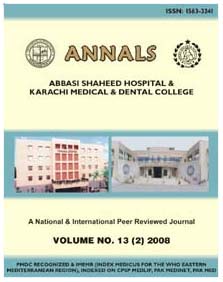| PATTERN OF ANALGESIC OVERUSE IN PROBABLE MEDICATION OVERUSE HEADACHE
1KHALID SHER, 2SHAHNAZ, 3QURAT-UL-AIN SALEEM, 4SALEEMULLAH ABRO
ABSTRACT
Objective: This
study aims to highlight the overuse of analgesics in patients with
chronic daily headache who meet criteria for probable medication
overuse headache.
Material & Methods: This was a cross-sectional
comparative study conducted at the department of Neurology, JPMC,
Karachi during a period of 1 year i.e. from 01-01-2011 to 31-12--2011.
All patients with chronic daily headache were screened for probable
Medication Overuse Headache. Total of 110 patients who met ICHD-II
(international classification of headache disorder) criteria for
probable Medication Overuse Headache (MOH) were included in this
study. Detailed history and neurological examination were performed
in all cases with appropriate blood workup, CSF studies and MRI+MRV
in those cases where required. Drug history was taken in detail
in all cases and pattern of overuse of different acute symptomatic
medications was assessed with reference to underlying primary headache
disorder.
Results: Total of 110 patients who met ICHD-II
(revised) Criteria for probable MOH were included in this study.
Females outnumbered males i.e. 2.3:1. This gender preference was
noted in all primary headache subtype. Migraine was found more frequently
(44.2%) in younger age groups with probable MOH while TTH (tension
type headache) (55%) and other primary (83%) headache disorder (including
Cluster Headache , New daily persistent headache ) were more frequent
disorders in old age patients with probable MOH. Among different
analgesic medications, simple analgesics were found to be the most
frequently overused acute symptomatic medication (66%) followed
by combination analgesics (40.9%) and triptans /ergots (14.6%).
Use of combinations of various acute symptomatic medications was
also assessed in patients with chronic primary headaches who met
the criteria for probable MOH.
Conclusion: Excessive use of acute symptomatic
drugs without consultation with the treating physician should be
discouraged. Patient education is very important about the genesis
of the problem. Prophylactic treatment and follow up visits should
be encouraged.
Keywords: overuse, analgesic, headache
|

